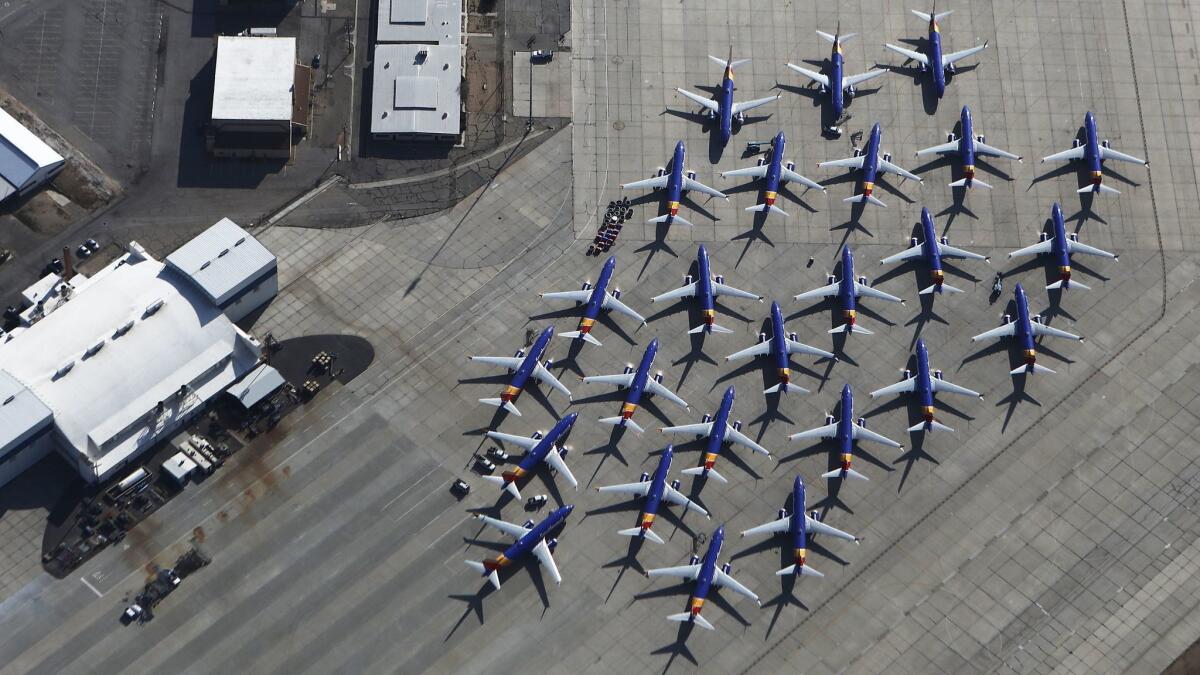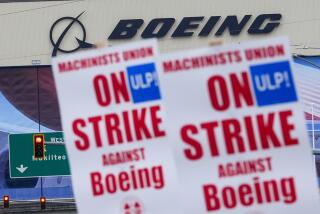Boeing pilot expressed worries about 737 Max safety in 2016, messages show

A high-ranking Boeing Co. pilot working on the 737 Max three years ago during its certification expressed misgivings about a feature since implicated in two fatal crashes, calling its handling performance “egregious,” according to 2016 instant messages.
The U.S. Federal Aviation Administration said Boeing alerted the Transportation Department late Thursday of instant messages between the pilot and another employee of the planemaker. The regulator said Boeing was aware of the communications for months.
“The FAA finds the substance of the document concerning,” the agency said in a statement. “The FAA is also disappointed that Boeing did not bring this document to our attention immediately upon its discovery.”
The messages are a stunning turn in the saga of Boeing’s top-selling jet, which has been grounded worldwide since March 13. Although the planemaker has said repeatedly that it followed proper procedures to certify the jet, the communications show that senior pilots at the company were concerned about a key aspect of its design and were worried that regulators had been misled.
The revelations also raise questions about Boeing’s chief executive, Dennis Muilenburg, who in less than two weeks is scheduled to appear before lawmakers in Washington to testify about the plane. Boeing directors stripped Muilenburg of his chairman role Oct. 11 in the wake of a damaging report from a multinational review of the plane’s certification.
Boeing stock tumbled 6.8% on Friday to $344 a share, its biggest drop since February 2016.
Unknowingly lied
The November 2016 instant messages, which were reviewed by Bloomberg News, were exchanges between between Mark Forkner, then Boeing’s chief technical pilot for the 737, and another 737 technical pilot, Patrik Gustavsson.
In the messages, Forkner and Gustavsson raised multiple concerns about the automated flight control system that has since been implicated in the two fatal crashes, including not being given data by the company’s test pilots. Forkner described his alarm at simulator tests in which he encountered troubling behavior in the system.
Boeing had earlier assured the aviation regulator that the feature known as Maneuvering Characteristics Augmentation System, or MCAS, was benign and didn’t need to be included in the plane’s flight manuals, according to a person familiar with the issue. Earlier in 2016, the FAA had approved the company’s request, said the person, who wasn’t authorized to speak on the issue and asked not to be named.
Forkner told Gustavsson that MCAS was “running rampant in the sim on me,” referring to simulator tests of the aircraft. “Granted, I suck at flying, but even this was egregious.”
Forkner expressed concern that he may have unknowingly misled the FAA. “So I basically lied to the regulators” inadvertently, he wrote.
“It wasn’t a lie, no one told us this was the case,” Gustavsson replied.
MCAS automatically pushes down the plane’s nose if it senses the craft is in danger of an aerodynamic stall.
In two crashes of 737 Max planes within less than five months — one off the coast of Indonesia last October and one in Ethiopia in March — similar malfunctions triggered MCAS to repeatedly push the planes’ noses down until pilots lost control and the planes dived. The crashes killed everyone aboard, a total of 346 people. After the second crash, the 737 Max was grounded worldwide.
“I’m levelling off at like 4000 ft, 230 knots and the plane is trimming itself like craxy,” Forkner said in the messages. “I’m like, WHAT?”
The communications between the pilots suggest MCAS was performing in simulator tests in ways they hadn’t expected.
“I don’t know, the test pilots have kept us out of the loop,” Gustavsson said.
Forkner replied, “they’re all so damn busy, and getting pressure from the program.”
Forkner is now a pilot at Southwest Airlines Co., the airline said in a statement.
“If you read the whole chat, it is obvious that there was no ‘lie,’” David Gerger, a lawyer for Forkner, said in an email. “The simulator was not reading right and had to be fixed to fly like the real plane. Mark’s career — at Air Force, at FAA, and at Boeing — was about safety. And based on everything he knew, he absolutely thought this plane was safe.”
‘More evidence’
FAA Administrator Steve Dickson sent a terse letter to Muilenburg on Friday demanding more information.
“I understand that Boeing discovered the document in its files months ago,” Dickson said. “I expect your explanation immediately regarding the content of this document and Boeing’s delay in disclosing the document to its safety regulator.”
Boeing gave the text messages to the Justice Department in February — the month before the second 737 Max crash — but didn’t inform the FAA because the exchange is sensitive to a criminal investigation being conducted, said a person familiar with the matter.
Knowing it would need to disclose the document to the House Transportation and Infrastructure Committee, which is conducting an investigation of the plane’s certification, the planemaker shared the document Thursday night with the Department of Transportation’s general counsel.
“This is more evidence that Boeing misled pilots, government regulators and other aviation experts about the safety of the 737 Max,” Jon Weaks, president of the Southwest Airlines Pilots Assn., said in a statement Friday. “It is clear that the company’s negligence and fraud put the flying public at risk.”
House Transportation and Infrastructure Committee Chairman Peter DeFazio (D-Ore.) said the exchange “essentially constitutes a smoking gun” of the pressure exerted by Boeing executives to get the 737 Max into service quickly. He said Muilenburg should resign.
The committee’s investigation into the FAA’s original certification of the 737 Max has returned hundreds of thousands of documents, including emails that, alongside interviews and whistle-blower reports, point to a pattern of “massive production pressure exerted from on high on Boeing employees to get this plane out, and apparently it was ‘get it out, no matter what,’ ” he said.
Boeing said it has been cooperating with the committee’s investigation.
“As part of that cooperation, today we brought to the committee’s attention a document containing statements by a former Boeing employee,” company spokesman Gordon Johndroe said in an email. “We will continue to cooperate with the committee as it continues its investigation. And we will continue to follow the direction of the FAA and other global regulators, as we work to safely return the 737 MAX to service.”
A lawyer representing Boeing in the matter, McGuireWoods’ Richard Cullen, said in a statement that Boeing “timely produced the Mark Forkner IM document to the appropriate authorities.”
Reuters previously reported on the FAA’s statement.
Aerospace analyst Richard Aboulafia said, “This doesn’t look good.”
Although the revelation may not slow Boeing and the FAA’s attempts to get the plane back in service, it further roils the company, said Aboulafia, vice president with Teal Group.
“To what degree was the board aware of this when it recommended changes?” he said. “Because this would appear to be exactly the oversight and governance issue that they should pay attention to.”
More to Read
Inside the business of entertainment
The Wide Shot brings you news, analysis and insights on everything from streaming wars to production — and what it all means for the future.
You may occasionally receive promotional content from the Los Angeles Times.










